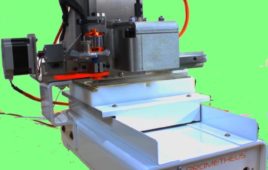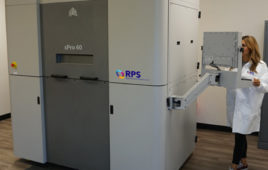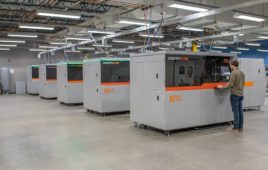Engineers at Stanford have demonstrated a high-resolution endoscope that is as thin as a human hair with a resolution four times better than previous devices of similar design. The so-called micro-endoscope is a significant step forward in high-resolution, minimally invasive bio-imaging with potential applications in research and clinical practice. Micro-endoscopy could enable new methods in diverse fields ranging from study of the brain to early cancer detection.
The new endoscope was developed by a team under the direction of Joseph Kahn, professor of electrical engineering at the Stanford School of Engineering. The results were published recently in the journal Optics Express and showcased in the Optical Society of America’s Spotlight on Optics.
Their prototype can resolve objects about 2.5 microns in size, and a resolution of 0.3 microns is easily within reach. A micron is one thousandth of a millimeter. By comparison, today’s high-resolution endoscopes can resolve objects only to about 10 microns. The naked eye can see objects down to about 125 microns.
Light paths
Kahn is best known for his work in fiber-optic communications—the ultra-fast data pipes essential to the Internet and large-scale data centers. His work on endoscopy began two years ago when he and a fellow Stanford electrical engineer, Olav Solgaard, were discussing biophotonics—a field of light-based technologies used in studying biological systems.
“Olav wanted to know if it would it be possible to send light through a single, hair-thin fiber, form a bright spot inside the body, and scan it to record images of living tissue,” said Kahn.
The opportunity and the challenge, Kahn and Solgaard knew, rested in multimode fibers in which light travels via many different paths, known in optics as modes; hence the name, multimode fiber. Light is very good at conveying complex information through such fibers—whether computer data or images—but it gets scrambled potentially beyond recognition along the way.
Kahn devised a way to undo the scrambling of information by using a miniature liquid crystal display called a spatial light modulator. To make this possible, Kahn and his graduate student, Reza Nasiri Mahalati, developed an adaptive algorithm—a specialized computer program—by which the spatial light modulator learned how to unscramble the light. Several years before, Kahn had set world records for transmission speeds using a similar trick to unscramble computer data transmitted through multimode fibers.
Research on the micro-endoscope took an unexpected and fortunate turn when Nasiri Mahalati mentioned seminal work in magnetic resonance imaging (MRI) done by John Pauly, another Stanford electrical engineer. Pauly had used random sampling to dramatically speed up image recording in MRIs.
“Nasiri Mahalati said, ‘Why not use random patterns of light to speed up imaging through multimode fiber?’ and that was it. We were on our way,” recalls Kahn. “The record-setting micro-endoscope was born.”
Confronting the Laws of Physics
In Kahn’s micro-endoscope, the spatial light modulator projects random light patterns through the fiber into the body to illuminate the object under observation. The light reflecting off the object returns through the fiber to a computer. The computer, in turn, measures the reflected power of the light and uses algorithms developed by Nasiri Mahalati and fellow graduate student Ruo Yu Gu to reconstruct an image.
Kahn and his students were stunned to discover their endoscope could resolve four times as many image features as the number of modes in the fiber.
“Previous single-fiber endoscopes were limited in resolution to the number of modes in the fiber,” said Kahn, “So this is a fourfold improvement.”
The result, however, raised a scientific conundrum for the team.
“This meant that, somehow, we were capturing more information than the laws of physics told us could pass through the fiber,” said Kahn. “It seemed impossible.”
The team wrestled with the paradox for several weeks before they came up with an explanation. The random intensity patterns mix the modes that can propagate through the fiber, increasing the number of modes fourfold and producing four times as much detail in the image.
“Previous research had overlooked the mixing. The unconventional algorithm we used for image reconstruction was the key to revealing the hidden image detail,” said Kahn.
The ultimate endoscope
Kahn and team have created a working prototype. The main limiting factor at this point is that the fiber must remain rigid. Bending a multimode fiber scrambles the image beyond recognition. Instead, the fiber is placed in a thin needle to hold it rigid for insertion.
Rigid endoscopes—those used frequently for surgeries— are common, but they often use relatively thick, rod-shaped lenses to yield good images. Flexible endoscopes on the other hand—the kind used in colonoscopies and ureteroscopies—usually employ bundles of tens of thousands of individual fibers, each conveying a single pixel of the image. Both types of endoscopes are bulky and have limited resolution.
A single fiber endoscope such as Kahn’s would be the ultimate minimally invasive imaging system, and has been the focus of intense research in optical engineering over the past few years.
Kahn is not the first to develop a single-fiber endoscope, but in boosting the resolution it is possible now to conceive of a fiber endoscope about two-tenths of a millimeter in diameter—just thicker than a human hair—that can resolve about 80,000 pixels at a resolution of about three-tenths of a micron. Today’s best flexible fiber endoscopes, by comparison, are about half-a-millimeter in diameter and can resolve roughly 10,000 pixels with a resolution of about three microns.
The future
A rigid single-fiber micro-endoscope could enable myriad new procedures for microscopic imaging inside living organisms. These range from analyzing neuronal cellular biology in brain tissue to studying muscle physiology and disease to the early detection of various forms of cancer.
Looking ahead, Kahn is excited about the potential of working with biomedical researchers to pioneer these applications, but being a physicist and an engineer at heart, he is most enthralled by the technical challenges of creating a flexible single-fiber endoscope.
“No one knows if a flexible single-fiber endoscope is even possible, but we’re going to try,” said Kahn.
For more information visit www.standford.edu.
Filed Under: Rapid prototyping




